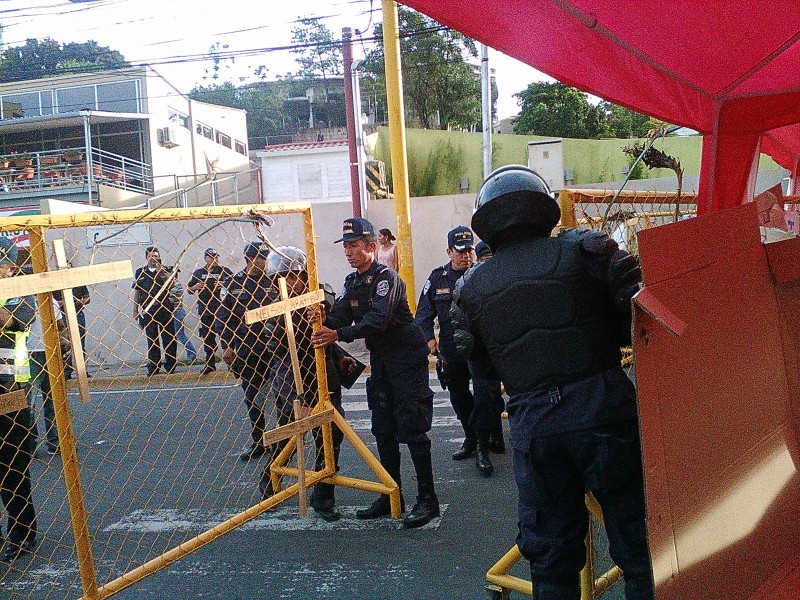
Police dismantle a site where demonstrators on a hunger strike protested against corruption in Honduras. Photo by Helen Ocampo.
Their hunger strike continued for two weeks before police moved in on July 7, 2015, and dispersed the demonstrators outside Casa Presidencial, the Honduran President's home in Tegucigalpa. Law enforcement say the intervention was necessary to “relocate” the protesters ahead of a visit by Organization of American States (OAS) delegates and United Nations officials.
Representatives of the UN and OAS came to Honduras [1] with the goal of facilitating a dialogue to bring to an end the weeks-long protests against the government of Juan Orlando Hernandez, who is accused of corruption.
#Honduras [2] Protests against corruption: hunger strike reaches its fifteenth day http://t.co/AhmBucJuzT [3] pic.twitter.com/YlePAT61Ot [4]
— Nodal (@InfoNodal) July 7, 2015 [5]
Protests against corruption: hunger strike reaches its fifteenth day
The demonstrations began as a result of the corruption scandal at the Social Security Institute for $200 million graft bust [6]. A group of young people, referred to on social media as los indignados (the outraged) [7], were able to mobilize hundreds of people in the so-called “March of the Torches.”
The removal of protesters was preceded by a midnight visit from a self-proclaimed member of FUSINA [8] (an elite Honduran security force), who threatened to clear them out. FUSINA was created by the current government in order to reduce organized gang violence, but has also been accused of intimidating civilians on behalf of the government.
Just before the demonstrators were dispersed, attorney Sagrario Prudoth, a human rights adviser to the Honduran Security Ministry, visited the crowd to assure everyone that they would not be removed. While this was happening, more than a hundred military and national guard troops proceeded to dismantle security fences and damage or destroy tents and other materials used by groups in support of the strike.
#Honduras [2]: Imminent removal of more protesters on hunger strike by riot police pic.twitter.com/z7LcvIeDcj [9]
— Giorgio Trucchi (@nicaraguaymas) June 28, 2015 [10]
Imminent removal of more protesters on hunger strike by riot police
Right now in the capital of #Honduras [2] Juan Orlando Hernandez removes protesters on hunger strike. All this has done is awaken the people and they won't go back to sleep. These actions have simply motivated people to march and DEMAND justice for this country http://t.co/MbkdoxjL0M [11]
— Outraged Honduras (@HIndignada) July 7, 2015 [12]
Right now in the capital of #Honduras [2] Juan Orlando Hernandez removes protesters on hunger strike. All this has done is awaken the people and they won't go back to sleep. These actions have simply motivated people to march and DEMAND justice for this country http://t.co/MbkdoxjL0M [11]
For German Ayala, one of the protesters, clearing out the protesters was “a desperate move by the government in order to fix up the street which they closed off in front of the Casa Presidencial so that we can't set up anywhere near it in order to create a certain image for international delegations.”
Tolupan [13] indigenous leader José María Pineda, on his hunger strike for eight days, assured that the “protests are peaceful. Violence creates more violence and this government is violent. We will however stay on a hunger strike and we will not move until they pay attention to our demands.”
The protesters are calling for the removal of the attorney general, the deputy prosecutor, and the prosecutor coordinator, as well as the resignation of the head of state and for the establishment of an international commission against impunity for Honduras [14], similar to the CICIG [15] in neighboring Guatemala.